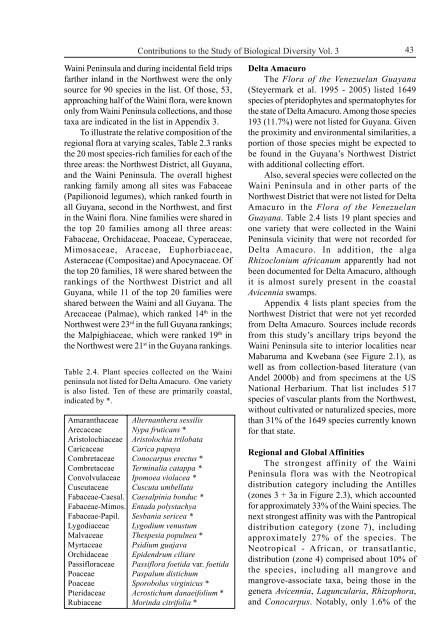Plant Community Structure, Fire Disturbance, and Recovery in ...
Plant Community Structure, Fire Disturbance, and Recovery in ...
Plant Community Structure, Fire Disturbance, and Recovery in ...
You also want an ePaper? Increase the reach of your titles
YUMPU automatically turns print PDFs into web optimized ePapers that Google loves.
Contributions to the Study of Biological Diversity Vol. 3<br />
Wa<strong>in</strong>i Pen<strong>in</strong>sula <strong>and</strong> dur<strong>in</strong>g <strong>in</strong>cidental field trips<br />
farther <strong>in</strong>l<strong>and</strong> <strong>in</strong> the Northwest were the only<br />
source for 90 species <strong>in</strong> the list. Of those, 53,<br />
approach<strong>in</strong>g half of the Wa<strong>in</strong>i flora, were known<br />
only from Wa<strong>in</strong>i Pen<strong>in</strong>sula collections, <strong>and</strong> those<br />
taxa are <strong>in</strong>dicated <strong>in</strong> the list <strong>in</strong> Appendix 3.<br />
To illustrate the relative composition of the<br />
regional flora at vary<strong>in</strong>g scales, Table 2.3 ranks<br />
the 20 most species-rich families for each of the<br />
three areas: the Northwest District, all Guyana,<br />
<strong>and</strong> the Wa<strong>in</strong>i Pen<strong>in</strong>sula. The overall highest<br />
rank<strong>in</strong>g family among all sites was Fabaceae<br />
(Papilionoid legumes), which ranked fourth <strong>in</strong><br />
all Guyana, second <strong>in</strong> the Northwest, <strong>and</strong> first<br />
<strong>in</strong> the Wa<strong>in</strong>i flora. N<strong>in</strong>e families were shared <strong>in</strong><br />
the top 20 families among all three areas:<br />
Fabaceae, Orchidaceae, Poaceae, Cyperaceae,<br />
Mimosaceae, Araceae, Euphorbiaceae,<br />
Asteraceae (Compositae) <strong>and</strong> Apocynaceae. Of<br />
the top 20 families, 18 were shared between the<br />
rank<strong>in</strong>gs of the Northwest District <strong>and</strong> all<br />
Guyana, while 11 of the top 20 families were<br />
shared between the Wa<strong>in</strong>i <strong>and</strong> all Guyana. The<br />
Arecaceae (Palmae), which ranked 14 th <strong>in</strong> the<br />
Northwest were 23 rd <strong>in</strong> the full Guyana rank<strong>in</strong>gs;<br />
the Malpighiaceae, which were ranked 19 th <strong>in</strong><br />
the Northwest were 21 st <strong>in</strong> the Guyana rank<strong>in</strong>gs.<br />
Table 2.4. <strong>Plant</strong> species collected on the Wa<strong>in</strong>i<br />
pen<strong>in</strong>sula not listed for Delta Amacuro. One variety<br />
is also listed. Ten of these are primarily coastal,<br />
<strong>in</strong>dicated by *.<br />
Amaranthaceae Alternanthera sessilis<br />
Arecaceae Nypa fruticans *<br />
Aristolochiaceae Aristolochia trilobata<br />
Caricaceae Carica papaya<br />
Combretaceae Conocarpus erectus *<br />
Combretaceae Term<strong>in</strong>alia catappa *<br />
Convolvulaceae Ipomoea violacea *<br />
Cuscutaceae Cuscuta umbellata<br />
Fabaceae-Caesal. Caesalp<strong>in</strong>ia bonduc *<br />
Fabaceae-Mimos. Entada polystachya<br />
Fabaceae-Papil. Sesbania sericea *<br />
Lygodiaceae Lygodium venustum<br />
Malvaceae Thespesia populnea *<br />
Myrtaceae Psidium guajava<br />
Orchidaceae Epidendrum ciliare<br />
Passifloraceae Passiflora foetida var. foetida<br />
Poaceae Paspalum distichum<br />
Poaceae Sporobolus virg<strong>in</strong>icus *<br />
Pteridaceae Acrostichum danaeifolium *<br />
Rubiaceae Mor<strong>in</strong>da citrifolia *<br />
43<br />
Delta Amacuro<br />
The Flora of the Venezuelan Guayana<br />
(Steyermark et al. 1995 - 2005) listed 1649<br />
species of pteridophytes <strong>and</strong> spermatophytes for<br />
the state of Delta Amacuro. Among those species<br />
193 (11.7%) were not listed for Guyana. Given<br />
the proximity <strong>and</strong> environmental similarities, a<br />
portion of those species might be expected to<br />
be found <strong>in</strong> the Guyana’s Northwest District<br />
with additional collect<strong>in</strong>g effort.<br />
Also, several species were collected on the<br />
Wa<strong>in</strong>i Pen<strong>in</strong>sula <strong>and</strong> <strong>in</strong> other parts of the<br />
Northwest District that were not listed for Delta<br />
Amacuro <strong>in</strong> the Flora of the Venezuelan<br />
Guayana. Table 2.4 lists 19 plant species <strong>and</strong><br />
one variety that were collected <strong>in</strong> the Wa<strong>in</strong>i<br />
Pen<strong>in</strong>sula vic<strong>in</strong>ity that were not recorded for<br />
Delta Amacuro. In addition, the alga<br />
Rhizoclonium africanum apparently had not<br />
been documented for Delta Amacuro, although<br />
it is almost surely present <strong>in</strong> the coastal<br />
Avicennia swamps.<br />
Appendix 4 lists plant species from the<br />
Northwest District that were not yet recorded<br />
from Delta Amacuro. Sources <strong>in</strong>clude records<br />
from this study’s ancillary trips beyond the<br />
Wa<strong>in</strong>i Pen<strong>in</strong>sula site to <strong>in</strong>terior localities near<br />
Mabaruma <strong>and</strong> Kwebana (see Figure 2.1), as<br />
well as from collection-based literature (van<br />
Andel 2000b) <strong>and</strong> from specimens at the US<br />
National Herbarium. That list <strong>in</strong>cludes 517<br />
species of vascular plants from the Northwest,<br />
without cultivated or naturalized species, more<br />
than 31% of the 1649 species currently known<br />
for that state.<br />
Regional <strong>and</strong> Global Aff<strong>in</strong>ities<br />
The strongest aff<strong>in</strong>ity of the Wa<strong>in</strong>i<br />
Pen<strong>in</strong>sula flora was with the Neotropical<br />
distribution category <strong>in</strong>clud<strong>in</strong>g the Antilles<br />
(zones 3 + 3a <strong>in</strong> Figure 2.3), which accounted<br />
for approximately 33% of the Wa<strong>in</strong>i species. The<br />
next strongest aff<strong>in</strong>ity was with the Pantropical<br />
distribution category (zone 7), <strong>in</strong>clud<strong>in</strong>g<br />
approximately 27% of the species. The<br />
Neotropical - African, or transatlantic,<br />
distribution (zone 4) comprised about 10% of<br />
the species, <strong>in</strong>clud<strong>in</strong>g all mangrove <strong>and</strong><br />
mangrove-associate taxa, be<strong>in</strong>g those <strong>in</strong> the<br />
genera Avicennia, Laguncularia, Rhizophora,<br />
<strong>and</strong> Conocarpus. Notably, only 1.6% of the
















